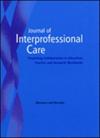Item response theory for before-after designs in interprofessional education research.
IF 1.9
3区 医学
Q3 HEALTH CARE SCIENCES & SERVICES
引用次数: 0
Abstract
Although Item Response Theory (IRT) has been recommended for helping advance interprofessional education (IPE) research, its use remains limited. This may be partly explained by potential misconceptions regarding IRT`s "limitation" to cross-sectional data. The aim of this study is to demonstrate how Item Response Theory (IRT) can be applied effectively in before-and-after designs in IPE research. Specifically, a two-week before-after design with survey methodology using the Extended Professional Identity Scale (EPIS), an interprofessional identity measure, was conducted among n = 146 mixed health-science students. Results indicated that EPIS increased significantly before-after intervention by .74 standardised mean differences, t146 = 7.73, p < .05. The before-after IRT model also gave a test-retest reliability estimate of .60 which was considered acceptable. Comparison of the IRT model with a conventional paired-t-test indicated similar effect size estimates of Cohen's d = .56 and .54, respectively. We demonstrate IRT`s flexibility to before-after studies in IPE. Application of this model can yield accurate changes in target IPE constructs, and it is advantageous to classical test theory vis-à-vis baseline differences.跨专业教育研究中前后设计的项目反应理论。
尽管项目反应理论(IRT)已被推荐用于推动跨专业教育(IPE)研究,但其使用仍然有限。造成这种情况的部分原因可能是人们对 IRT "局限于 "横截面数据的潜在误解。本研究旨在展示项目反应理论(IRT)如何有效地应用于 IPE 研究中的前后设计。具体来说,研究人员使用专业间认同测量量表(EPIS),对 n = 146 名混合健康科学专业的学生进行了为期两周的前后设计调查。结果表明,EPIS 在干预前和干预后都有明显提高,标准化均差为 0.74,t146 = 7.73,p < .05。干预前和干预后的 IRT 模型也给出了 0.60 的重测可靠性估计值,这被认为是可以接受的。将 IRT 模型与传统的配对检验进行比较,结果显示两者的效应大小估计值相似,分别为 Cohen's d = .56 和 .54。我们证明了 IRT 在 IPE 前后研究中的灵活性。应用该模型可以准确得出 IPE 目标建构的变化,而且相对于基线差异而言,它比经典测试理论更具优势。
本文章由计算机程序翻译,如有差异,请以英文原文为准。
求助全文
约1分钟内获得全文
求助全文
来源期刊

Journal of Interprofessional Care
HEALTH CARE SCIENCES & SERVICES-
CiteScore
5.80
自引率
14.80%
发文量
124
审稿时长
6-12 weeks
期刊介绍:
The Journal of Interprofessional Care disseminates research and new developments in the field of interprofessional education and practice. We welcome contributions containing an explicit interprofessional focus, and involving a range of settings, professions, and fields. Areas of practice covered include primary, community and hospital care, health education and public health, and beyond health and social care into fields such as criminal justice and primary/elementary education. Papers introducing additional interprofessional views, for example, from a community development or environmental design perspective, are welcome. The Journal is disseminated internationally and encourages submissions from around the world.
 求助内容:
求助内容: 应助结果提醒方式:
应助结果提醒方式:


